Hello,
First, I am a complete noob with high voltage stuff. I'm learning, but I need help by someone looking over my shoulder.
I recently came into posession of a Heathkit IO-4205 5MHz Dual Trace Oscilloscope. The documentation is copyright 1978. I'm told it works.
I opened it up to check the caps before I applied power, and found the following black caps and wanted to know what they were. They are on the power supply board. I was able to read the name and model and came up with, "Nytronics 162J-1, 0.1uF, 20% tolerance, 2000VDC."

I spent some time with Google and was not able to find much about these caps and only a very little bit about Nytronics in general. Nothing like a datasheet. Frustrated, I finally had a RTFM moment and checked the Heathkit Manual. These caps are located with diagrams and identified as paper caps.
Paper. Ok, I read questionable: Don't apply power, Adam, until you know the condition of the caps. But, I do not have any way to test ESR and I am unwilling to try any "wet finger test." I'm far more comfortable with replacing them outright.
I also have the complete schematic. I located the caps in question. The relevant part is here.

These caps (C301, C302, C303) appear to be smoothing and filter caps (please correct me if I am using the wrong terms here). But it also appears that the test voltage on one lead of one cap is -2000VDC -- right at the limit for the cap with absolutely no headroom. This does not seem smart to me.
So, I am proposing to replace these 3 caps with the yellow KEMET 0.1uF 5% film cap (polypropylene) rated for 3000VDC (KEMET C4CAYUD3100AA1J). I am reasonably confident they will do the job adequately.
This, then, brings me to my specific questions:
1. Am I considering the proper type (dielectric? what is the proper term?) of capacitor for these replacements?
2. Is my thinking related to using a 3000VDC rated cap correct, or is there still enough "room" available in the 2000VDC rated cap (also, if there is enough room in the 2K cap please explain how this is possible)?
3. The paper cap appears to be polarized (from the Heathkit Manual) and my proposed replacement appears not to be polarized. I recognize that it may be bad form to replace a polarized cap with a non-polarized one. Should I consider the polarized-to-polarized-replacement rule to be more of a hard-rule than a mild-suggestion? If hard rule, please help me find an appropriate replacement cap.
4. There are larger (1200uF) electrolytic caps for this power supply as well. They show no physical signs of leaking. Since I have no way of testing ESR, should I consider replacing them at the same time?
5. What am I not considering? I know this is a loaded question, but I honestly don't know what I don't know. So, can you think of anything I should be looking at before I put power to this device?
Thanks in advance!
First, I am a complete noob with high voltage stuff. I'm learning, but I need help by someone looking over my shoulder.
I recently came into posession of a Heathkit IO-4205 5MHz Dual Trace Oscilloscope. The documentation is copyright 1978. I'm told it works.
I opened it up to check the caps before I applied power, and found the following black caps and wanted to know what they were. They are on the power supply board. I was able to read the name and model and came up with, "Nytronics 162J-1, 0.1uF, 20% tolerance, 2000VDC."
I spent some time with Google and was not able to find much about these caps and only a very little bit about Nytronics in general. Nothing like a datasheet. Frustrated, I finally had a RTFM moment and checked the Heathkit Manual. These caps are located with diagrams and identified as paper caps.
Paper. Ok, I read questionable: Don't apply power, Adam, until you know the condition of the caps. But, I do not have any way to test ESR and I am unwilling to try any "wet finger test." I'm far more comfortable with replacing them outright.
I also have the complete schematic. I located the caps in question. The relevant part is here.
These caps (C301, C302, C303) appear to be smoothing and filter caps (please correct me if I am using the wrong terms here). But it also appears that the test voltage on one lead of one cap is -2000VDC -- right at the limit for the cap with absolutely no headroom. This does not seem smart to me.
So, I am proposing to replace these 3 caps with the yellow KEMET 0.1uF 5% film cap (polypropylene) rated for 3000VDC (KEMET C4CAYUD3100AA1J). I am reasonably confident they will do the job adequately.
This, then, brings me to my specific questions:
1. Am I considering the proper type (dielectric? what is the proper term?) of capacitor for these replacements?
2. Is my thinking related to using a 3000VDC rated cap correct, or is there still enough "room" available in the 2000VDC rated cap (also, if there is enough room in the 2K cap please explain how this is possible)?
3. The paper cap appears to be polarized (from the Heathkit Manual) and my proposed replacement appears not to be polarized. I recognize that it may be bad form to replace a polarized cap with a non-polarized one. Should I consider the polarized-to-polarized-replacement rule to be more of a hard-rule than a mild-suggestion? If hard rule, please help me find an appropriate replacement cap.
4. There are larger (1200uF) electrolytic caps for this power supply as well. They show no physical signs of leaking. Since I have no way of testing ESR, should I consider replacing them at the same time?
5. What am I not considering? I know this is a loaded question, but I honestly don't know what I don't know. So, can you think of anything I should be looking at before I put power to this device?
Thanks in advance!
Comment